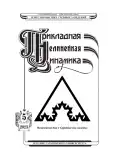Multistability near the boundary of noise-induced synchronization in ensembles of uncoupled chaotic systems
- Authors: Illarionova E.D.1, Moskalenko O.I.1
-
Affiliations:
- Saratov State University
- Issue: Vol 31, No 5 (2023)
- Pages: 566-574
- Section: Articles
- URL: https://journals.rcsi.science/0869-6632/article/view/251288
- DOI: https://doi.org/10.18500/0869-6632-003061
- EDN: https://elibrary.ru/KVJVOV
- ID: 251288
Cite item
Full Text
Abstract
About the authors
Ekaterina Dmitrievna Illarionova
Saratov State University
ORCID iD: 0000-0003-1912-863X
ul. Astrakhanskaya, 83, Saratov, 410012, Russia
Olga Igorevna Moskalenko
Saratov State University
ORCID iD: 0000-0001-5727-5169
Scopus Author ID: 10038769200
ResearcherId: D-4420-2011
ul. Astrakhanskaya, 83, Saratov, 410012, Russia
References
- Pikovsky A., Rosenblum M., Kurths J. Synchronization: A Universal Concept in Nonlinear Sciences. Cambridge: Cambridge University Press, 2001. 432 p. doi: 10.1017/CBO9780511755743.
- Anishchenko V. S., Astakhov V., Vadivasova T., Neiman A., Schimansky-Geier L. Nonlinear Dynamics of Chaotic and Stochastic Systems: Tutorial and Modern Developments. Berlin Heidelberg: Springer-Verlag, 2007. 446 p. doi: 10.1007/978-3-540-38168-6.
- Balanov A., Janson N., Postnov D., Sosnovtseva O. Synchronization: From Simple to Complex. Berlin Heidelberg: Springer-Verlag, 2009. 426 p. doi: 10.1007/978-3-540-72128-4.
- Boccaletti S., Pisarchik A. N., del Genio C. I., Amann A. Synchronization: From Coupled Systems to Complex Networks. Cambridge: Cambridge University Press, 2018. 264 p. doi: 10.1017/978110 7297111.
- Boccaletti S., Kurths J., Osipov G., Valladares D. L., Zhou C. S. The synchronization of chaotic systems // Physics Reports. 2002. Vol. 366, no. 1–2. P. 1–101. doi: 10.1016/S0370-1573(02)00137-0.
- Rosenblum M. G., Pikovsky A. S., Kurths J. Synchronization approach to analysis of biological systems // Fluctuation and Noise Letters. 2004. Vol. 4, no. 1. P. L53–L62. doi: 10.1142/S0219477 504001653.
- Короновский А. А., Москаленко О. И., Храмов А. Е. О применении хаотической синхронизации для скрытой передачи информации // Успехи физических наук. 2009. Т. 179, № 12. С. 1281–1310. doi: 10.3367/UFNr.0179.200912c.1281.
- Zhang F., Chen G., Li C., Kurths J. Chaos synchronization in fractional differential systems // Phil. Trans. R. Soc. A. 2013. Vol. 371, no. 1990. P. 20120155. doi: 10.1098/rsta.2012.0155.
- Стрелкова Г. И., Анищенко В. С. Пространственно-временные структуры в ансамблях связанных хаотических систем // Успехи физических наук. 2020. Т. 190, № 2. С. 160–178. doi: 10.3367/UFNr.2019.01.038518.
- Toral R., Mirasso C. R., Hernandez-Garcia E., Piro O. Analytical and numerical studies of noise-induced synchronization of chaotic systems // Chaos. 2001. Vol. 11, no. 3. P. 665–673. doi: 10.1063/1.1386397.
- Wang Y., Lai Y.-C., Zheng Z. Route to noise-induced synchronization in an ensemble of uncoupled chaotic systems // Phys. Rev. E. 2010. Vol. 81, no. 3. P. 036201. doi: 10.1103/PhysRevE.81.036201.
- Москаленко О. И., Короновский А. А., Шурыгина С. А. Перемежающееся поведение на границе индуцированной шумом синхронизации // ЖТФ. 2011. Т. 81, № 9. С. 150–153.
- Moskalenko O. I., Koronovskii A. A., Selskii A. O., Evstifeev E. V. On multistability near the boundary of generalized synchronization in unidirectionally coupled chaotic systems // Chaos. 2021. Vol. 31, no. 8. P. 083106. doi: 10.1063/5.0055302.
- Москаленко О. И., Евстифеев Е. В. О существовании мультистабильности вблизи границы обобщенной синхронизации в однонаправленно связанных системах со сложной топологией аттрактора // Известия вузов. ПНД. 2022. Т. 30, № 6. С. 676–684. doi: 10.18500/0869-6632- 003013.
- Hramov A. E., Koronovskii A. A., Moskalenko O. I. Are generalized synchronization and noise induced synchronization identical types of synchronous behavior of chaotic oscillators? // Phys. Lett. A. 2006. Vol. 354, no. 5–6. P. 423–427. doi: 10.1016/j.physleta.2006.01.079.
Supplementary files










